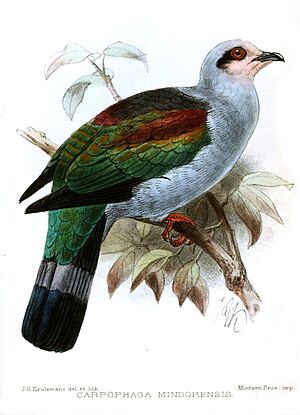Mindoro imperial pigeon facts for kids
Quick facts for kids Mindoro imperial pigeon |
|
|---|---|
 |
|
| Conservation status | |
| Scientific classification | |
| Genus: |
Ducula
|
| Species: |
mindorensis
|
The Mindoro imperial pigeon (Ducula mindorensis) is a special bird that lives only on the island of Mindoro in the central Philippines. It's also called the Great Mindoro pigeon or Pink-throated Imperial pigeon. This amazing bird is the biggest pigeon in the Philippines, growing up to 50 centimeters long!
Sadly, the Mindoro imperial pigeon is an endangered bird. This means there are not many left in the wild. Experts believe there are only about 600 to 1,700 of these birds remaining. Their biggest problems are losing their homes (habitat loss) and being hunted.
Contents
What the Mindoro Imperial Pigeon Looks Like
The Mindoro imperial pigeon is the largest Philippine pigeon. It can be from 42 to 50 centimeters long. Its wings are about 24 centimeters long. Its tail measures from 15 to 17 centimeters.
Its forehead and throat are a soft pinkish-grey color. The head, neck, and most of its underside are bluish-grey. This color is darkest on its belly and under its tail. The back of its neck changes from dark grey to black. This black color goes around the top part of its back.
The rest of its back and the inner parts of its wings are a shiny bronzy-red to green color. Most of the bird's upper body is a bright emerald green. It has a black ring around and behind its eye. Its tail is greenish-black with a clear grey band in the middle. The feathers under its tail are grey with a hint of cinnamon.
This pigeon has a black beak. Its legs are a pinkish-red color. Male pigeons have bright yellow eyes and red eyelids. Female pigeons have brownish-yellow eyes and yellow-orange eyelids. We don't have much information about how young pigeons look.
About the Mindoro Imperial Pigeon's Family
The Mindoro imperial pigeon belongs to a group of birds called Ducula. This group is also known as the imperial pigeons. The scientific name for this bird is Ducula mindorensis.
It was first described by a person named John Whitehead in 1896. Before that, it was known by other names like Carpophaga mindorensis and Zonophaps mindorensis.
This pigeon is closely related to another bird called Ducula radiata. They form what scientists call a "superspecies." It is also related to Ducula poliocephala and Ducula forsteni. These three species might connect the Ptilinopus fruit doves to other imperial pigeons.
How the Mindoro Imperial Pigeon Behaves
You might see the Mindoro imperial pigeon alone, in pairs, or in small groups of up to four birds. These pigeons often rest together in the treetops. They sometimes roost with other pigeons like Ducula poliocephala and Columba vitiensis.
They tend to be very quiet and hard to spot. This makes it tricky for people to watch them when they are resting.
Vocalization
We don't have any recordings of their calls. However, we know they make a clear two-part call. Their voice sounds similar to other imperial pigeons on Mindoro. But their call is much deeper and more echoing. You can often hear the Mindoro imperial pigeon's call early in the morning, at dawn.
Diet
We don't know much about what the Mindoro imperial pigeon eats. They have been seen eating fruits. These fruits can be small berries or even large ones, as big as a pigeon's egg!
Reproduction
There isn't much information about how these pigeons breed. One male pigeon was found to be ready for breeding in April. A young pigeon was found in August. This suggests they might breed around those times of the year.
Where the Mindoro Imperial Pigeon Lives and Its Protection
The Mindoro imperial pigeon lives all over Mindoro island. They need thick, closed forests to survive. They used to live mostly in mountain forests, high up at over 1000 meters.
However, in 1991, most of these birds were seen in the lower parts of forests. These forests were still quite high up, between 800 and 950 meters.
The IUCN Red List has listed this bird as Endangered. This means it is at a very high risk of disappearing forever. As mentioned, there are only an estimated 600 to 1,700 adult birds left.
This pigeon is rare and not easy to find. But it is known to be seen more often on Mount Ilong and Mount Halcon. Their forest homes are in danger because of logging, farming, and other ways forests are being destroyed.
To help protect these birds, experts suggest a few things. They want to do more surveys to learn about how many birds there are. They also want to understand where they live and how they live. It's also important to protect the remaining forests on Mount Halcon. They are also working to get better protection for these areas.


